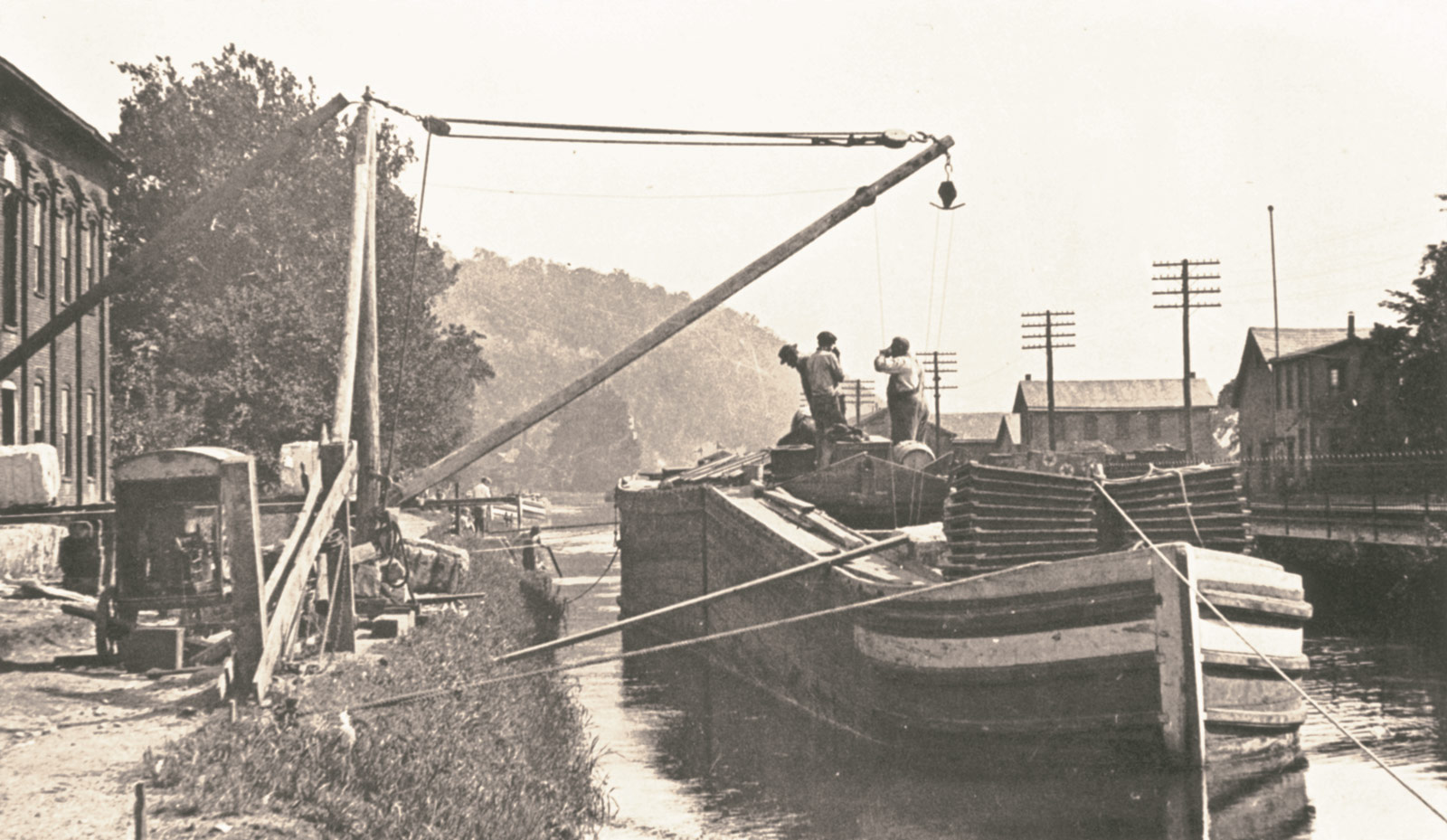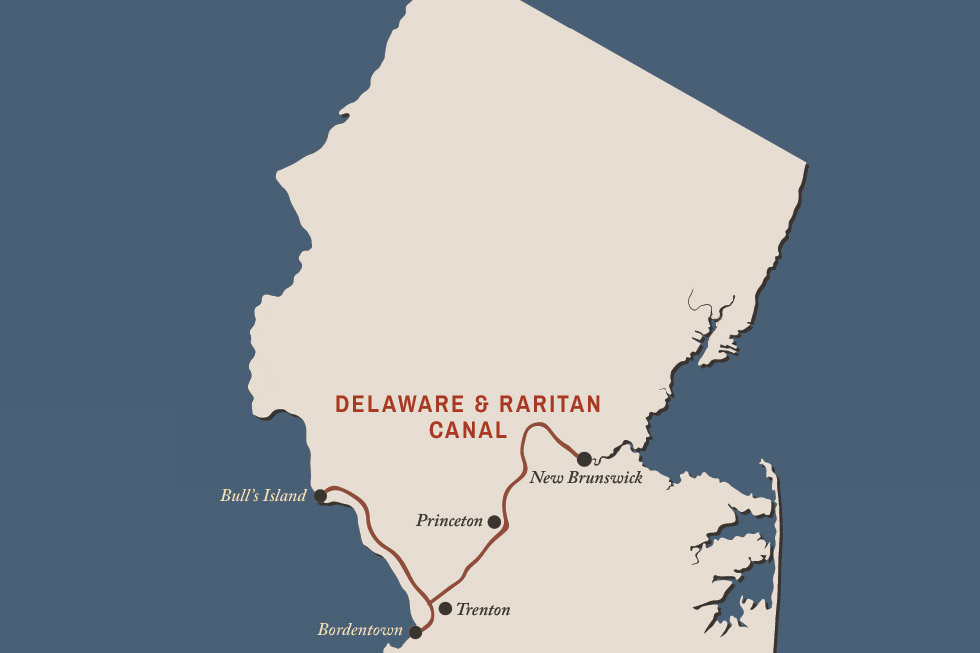Explore the Delaware and Raritan Canal
The Delaware & Raritan Canal went from Bordentown on the Delaware River, across the narrow waist of New Jersey to New Brunswick on the Raritan River, a distance of 44 miles. Its source of water was the Delaware River at Raven Rock, 22 miles north of Trenton. From here, a navigable feeder brought water to the summit level in Trenton, 57 feet above sea level. The water then flowed south to Bordentown and northeast to New Brunswick. The canal was a fairly level one, with only 14 locks on the main canal to overcome the elevation changes of 115 feet. It was a critical factor in the 19th-century industrial and commercial development of the region through which it passed.
Although simple in construction and engineering compared to the Morris Canal, it overshadowed its northern neighbor in many ways. It was a large canal, with a depth of 8 feet and locks that were 24 feet wide by 220 feet long. The banks were “rip-rapped” with stone so that vessels could move at a reasonable speed without washing the banks into the canal. All of its bridges were swing bridges that pivoted horizontally so that vessels of any mast height could transit the canal. The locks were operated by steam-powered winches and valves after 1868. A large volume of traffic moved through the canal. Boats from the Schuylkill Canal and the Delaware Canal, both in Pennsylvania, used this waterway. The tonnage in 1866 was 2,857,233 tons—83% of which was coal. Troops and war supplies moved through the canal in three wars, and the canal was a link in the Atlantic Intracoastal Waterway, a link that is missing today.
One of the most interesting aspects of the Delaware & Raritan Canal was the large variety of boats that passed through it. Theses included mule-towed canal boats and sailboats, steam tugs towing barges, freight boats, luxury yachts, and naval vessels. Canal boats from most of the canals on the East Coast traversed the D&R.
The canal was chartered in 1830. In 1831 the Delaware & Raritan Canal and the Camden & Amboy Railroad, the precursor of the Pennsylvania Railroad, were combined as “the Joint Companies.” The canal opened for through navigation in 1834. Its last season of operation was 1932. In 1974, by an act of the legislature, the Delaware & Raritan Canal State Park was created. Today the main canal and the feeder form a linear park used extensively for recreation. Under the direction of the New Jersey Water Supply Authority, the canal serves as a water supply for about 1,000,000 customers in Central New Jersey.

Delaware and Raritan Canal section boat docking.

The Delaware and Raritan Canal connected central New Jersey towns and cities during its time including Bull’s Island, Princeton and New Brunswick.
GENERAL INFORMATION
| Main canal | |
|---|---|
|
Bordentown to New Brunswick
| 44 miles, 14 locks |
| Feeder canal | |
|
Raven Rock to Trenton
| 22 miles (4 locks, 3 of which are guard locks) |
|
Dimensions
| 60 feet wide x 6 feet deep |
| Summit level at Trenton | |
| 57 feet above sea level | |
| People | |
|
Robert F. Stockton
| First president, serving until his death in 1866 |
|
Canvass White
| First chief engineer, serving until his death in 1834 |
|
Ashbel Welch
| Chief engineer of the Joint Companies, beginning in 1835 |
|
Col. James Neilson
| First treasurer |
| Chronology | |
|
1830
| Charter granted for the Delaware & Raritan Canal Company and the Camden & Amboy Railroad |
|
1831
| D&R Canal and the C&A Railroad became the Joint Companies |
|
1834
| Canal opened for through traffic |
|
1847
| Connection established to Pennsylvania’s Delaware Canal by means of a cable ferry at Lambertville |
|
1850
| Construction began on Belvidere & Delaware Railroad along the original feeder towpath; towpath was moved to the opposite side |
|
1851
| Canal depth dredged to 8 feet |
|
1853
| Locks on main canal lengthened to 220 feet and banks “rip-rapped” with stone |
|
1866
| Peak year for freight; 2,857,233 tons, 83% of which was coal |
|
1868
| Installation of steam-powered winches and steam activated valves |
|
1902
| Pennsylvania Railroad viaduct constructed in New Brunswick, thus limiting mast height to 50 feet |
|
1929
| Peak year for pleasure boaters; 941 non-commercial vessels |
|
1932
| Last season for boating |
|
1934
| State took over canal properties |
|
1944
| Construction began to convert canal to a water supply system |
|
1973
| Canal entered on the National Register of Historic Places |
|
1974
| Delaware & Raritan Canal State Park and the D&R Canal Commission created |
Become A Member
The annual membership contribution is $25.00 per individual or family. Payment may be made by credit card or check.

